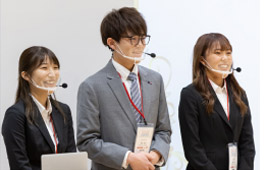
左から
近森 由衣 Chikamori Yui
上智大学 経済学部 2年
福島 慶悦 Fukushima Keietsu
上智大学 総合グローバル学部 2年
宮園 佳耶 Miyazono Kaya
上智大学 国際教養学部 2年
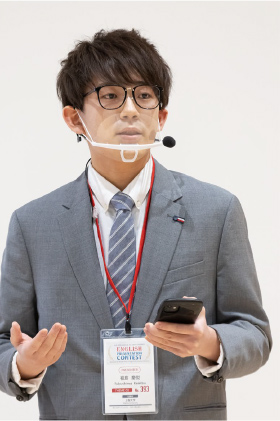
Fukushima Keietsu
Good afternoon, everyone. I would like to start the presentation by asking one question.
Have you ever felt powerless when you want to involve the people around you? We are asking this question because we had a similar experience recently when working to achieve Goal 13 in the SDGs.
This is the issue we used to face in our dormitory. Students use many plastic bottles, but the labels and caps were not being removed correctly. This is a problem because not removing the recyclables in the proper method decreases the recycling efficiency, and this, in turn, produces a huge amount of greenhouse gasses.
To solve this problem in our dormitory, we made a poster about the correct recycling method. However, there was no positive response and nothing changed. We realized that it wasn't very effective because simply explaining the seriousness of environmental problems does not resonate with people who are not interested in such issues.
Just like us, we believe you also had a similar experience, the challenge in changing others' actions for the good of all. We know that we need "everyone's" involvement to solve the environmental problem. But, again, it is very difficult to get "everyone's" help. In this situation, what is the best way to involve people who have no interest?
Now, I want to show a speech given by Shinjiro Koizumi at the United Nation Climate Action Summit in 2019.
"In politics there are so many issues, sometimes boring. On tackling such a big-scale issue like climate change, it's gotta be fun, it's gotta be cool, it's gotta be sexy."
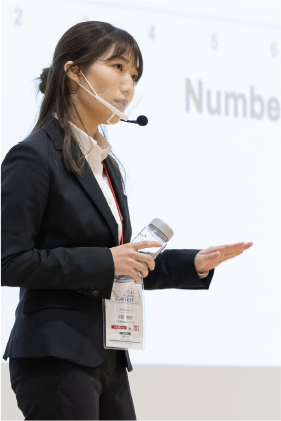
As you can imagine, the word sexy caused controversy, however, we focused on the key words fun and cool. We thought that more dormitory students would become involved if we made throwing away trash fun and cool.
From all the ideas and projects that we have done, we would like to introduce two ideas that we think will help people who are not interested in the environmental problem become more involved. We are hoping that you will work together with us to reduce plastic waste!
Miyazono Kaya
The first idea that I would like to introduce is what we call the ''The Ultimate Choice Box'', which we actually conducted in our dorm as a way to promote the proper recycling methods.
This project came to our mind when we learned that Japan has one of the highest recovery rates of plastic bottles in the world, 93%, which is great! But, on the other hand, the recycling rate of plastic bottles has not reached the recovery rate, which means that Japan does not actually recycle all of the plastic bottles collected.
Moreover, when it comes to bottle-to-bottle recycling, which means breaking down the used plastic bottles and using them again, the rate for Japan is only 10 percent, which is really bad!
But why is that?
Plastic bottles with leftover beverage or caps and labels attached are the main causes that are creating the gap between the recovery rate and the recycling rate.
And, now we will get into the main topic, ''The Ultimate Choice Box''.
This project is based on the idea of ‘‘making eco-action a fun and habitual one’’. What we mean by eco-action here is to recycle plastic bottles in a proper way unconsciously and to raise recycling efficiency.
More precisely, we placed a piece of paper with the question written on it and two answer boxes to collect plastic waste. The topic would be something like “which one do you like, こしあん or 粒あん?” And people will use bottle caps to vote for their answer.
As you can see in this picture, before we started this project, most of the plastic bottles were thrown away with the caps and labels still attached. However, ''The Ultimate Choice Box''' enables us to consistently collect around 300 caps each month from May.
In order to engage a larger number of people to take eco-actions, we believe making eco-action an unconscious habit is more important than appealing to people's conscience.
This project can apply to many situations and places such as schools, offices, or even the place next to the vending machines. Among these options, placing the “Ultimate Choice Box” next to the Vending machines would be the best idea, because you can throw away and recycle the plastic bottles properly while you are there.
However, recycling the plastic bottles in a proper way to boost recycling efficiency is not the only thing that we need to work on. Have you ever thought about how to reduce the usage of plastic bottles?
Chikamori Yui
The second proposal to involve people who are not interested in environmental issues is the "MY Oasis Project". The purpose of this project is to "reduce plastic bottle waste" by encouraging people to use My Bottle, which is a reusable water bottle.
Do you use “My bottle” when you go out?
"My Bottle" is one of the concrete actions we can easily take. It is said that "if you use your My bottle 12 times, the CO2 emission will be lower than buying plastic bottles". However, according to the NGO Greenpeace Japan, only 20% of the people who have My Bottle use it. Even I don't use My Bottle sometimes! Why is this happening?
We surveyed 560 students at Sophia University about their reasons for not carrying their My Bottles. These were the common answers we received: I know it's good for the environment, but… “there are few water servers” and “I end up buying a plastic bottle when the water bottle is empty”
From these results, we believe that if there is a social system that easily gets drinks into water bottles wherever we go, these problems will be solved, and therefore increase the incentive to carry My Bottles.
This is what the My Oasis Project is all about.
In this "My Oasis Project", we came up with two mechanisms. First, a water bottle called "My Oasis Bottle" will be produced and sold as part of the project. A portion of the sales will be used to manage the project and purchase water servers, which will be placed in public.
However, we will not just increase the number of water servers, but also implement a system to properly inform people about the water servers.
The second mechanism of this project is the QR code. By holding up your cell phone to this QR code, you will be taken to a website where you can find the location of the water servers. By printing these QR codes on My Oasis bottles and putting them up as posters in public places, people can get information about nearby water servers. This can give people the option of not buying plastic bottles.
In order to expand this project, we will first seek organizations such as universities and companies that will help support and manage our proposal. We will then have the My Oasis bottles commercialized as goods to raise awareness and funds for the project.
In fact, we are now working with Sophia University to implement the project. Also, water servers are becoming more popular in major overseas cities, and we believe that there is a wide range of opportunities for sponsorship from tourism and local government.
Miyazono Kaya
In conclusion, ''The Ultimate Choice Box'' and "My Oasis Project" are the ideas that we presented to make a larger number of people take eco-action without forcing them to do so.
We tried to spice up these two ideas to create a win-win situation between the environment and humans. And these two ideas lead us to build a sustainable cycle.
Finally, to quote Michael Jackson, “We are the world, we are the children”, we really do have to stand united to protect our planet and make it a better place, for ourselves and for our future. Thank you.
福島
みなさん、こんにちは。ひとつの質問からプレゼンテーションを始めたいと思います。
身の回りの人々を巻き込むうえで力の足りなさを感じたことはありませんか。こんな質問をしているのは、SDGsの目標13に取り組むうえで私たちも同様の経験をしたからです。
この写真は私たちの寮がかつて直面していた課題を表しています。たくさんのペットボトルが使われていましたが、ラベルとキャップが取り外されておらず、分別が正しく行われていませんでした。正しい方法で分別が行われないと、リサイクルの効率性が下がるという問題が生じます。その結果として、膨大な量の温室効果ガスの排出につながるのです。
寮におけるこの問題を解決するために、私たちは正しいペットボトルのリサイクル方法に関して記したポスターを制作しました。しかし、寮生からのポジティブな反応は得られず、変化もありませんでした。では、なぜ効果がなかったのでしょうか?単に環境問題の深刻さを説明するだけでは、その問題に関心を抱いていない人々の心には響かないからだと気づかされました。
私たちのように、良かれと思って他人のために起こした行動に周りがついてきてくれなかったり、他人の行動を変える難しさを感じた経験は、みなさんにもきっとあると思います。環境問題を解決するには「すべての人の」関与が必要であることを私たちは理解しています。しかし、「すべての人の」協力を得ることは極めて難しいのです。では、関心の人々を巻き込んでいく最善の方法とは何でしょうか?
ここで、2019年の国連気候行動サミットで小泉進次郎氏が行ったスピーチを紹介します。
「政治には実に多くの問題があり、時にそれは退屈なものだ。気候変動のような大規模な課題に取り組むとき、それは面白く、クールで、セクシーでなければならない」
ご想像の通り、セクシーという言葉が論争を起こしていまいましたが、私たちは「面白く、クール」というキーワードに注目しました。もしゴミを捨てることが面白く、クールになったとしたら、寮生たちはもっと関心を持つのではないかと私たちは考えたのです。
私たちのアイデア、そして取り組んできたプロジェクトの中から、環境問題に関心のない人々を巻き込む2つのアイデアを紹介させていただきたいと思います。みなさんも、プラスチックゴミを削減するために私たちとともに取り組んでいただけることを願っています。
宮園
最初のアイデアとして、「究極の選択ボックス」と呼んでいるものを紹介させていただきます。これは実際に私たちの寮において、適切なリサイクル方法を寮生に定着させる手段として実践したものです。
このプロジェクトは、私たちが日本は世界でも有数の高いペットボトルの回収率を誇ることを知ったときに思いついたものです。日本のペットボトル回収率はなんと93%、非常に高く凄い数字です!しかし、その一方で、ペットボトルのリサイクル率はこの回収率に到達していません。つまり、日本は回収したすべてのペットボトルをリサイクルできているわけではないのです。
さらに言えば、ボトルからボトルへのリサイクル、つまり使用済みペットボトルを分解しての再利用については、集められたペットボトルの内のわずか10パーセントしか行われていないのです。非常に悪い数字だと思います。
でも、それはなぜでしょうか?
飲み残し、キャップ、ラベルがあるペットボトルが、回収率とリサイク率のギャップを生んでいる大きな要因です。
では、本題の「究極の選択ボックス」の説明に入ります。
このプロジェクトは「エコアクションを楽しくかつ習慣的なものにする」というアイデアに基づいています。ここでのエコアクションとは、ペットボトルを無意識のうちに適切にリサイクルして、効果的にリサイクルを加速することを意味します。
詳しく説明すると、質問を書いた紙を貼り、プラスチックゴミを収集する2つの箱を設置しました。質問の例としては、「どっちが好き? こしあん、それとも、つぶあん?」といったものです。人々はペットボトルのキャップを使って、自分の答えを設置されている2つの投票箱のどちらかに投票するのです。
スライドに添付されている写真を見ていただくとわかる通り、プロジェクトを始める前は、ほとんどのペットボトルがキャップとラベルをつけたまま捨てられていました。しかし、「究極の選択ボックス」によって、5月以来、毎月300個ものキャップを継続的に集めることができています。
多くの人々をエコアクションの実践へと引き込むには、人々の良心に訴えかけるよりも、エコアクションを無意識な習慣にしていくことがより重要であると確信しました。
このプロジェクトは、学校、オフィス、さらには自動販売機の隣の場所など多くの状況や場所に応用できます。これらのなかで、「究極の選択ボックス」を自動販売機の隣に設置するのは最善のアイデアです。なぜなら、ペットボトルを捨てるという行為と、リサイクルするという行為を同時に行うことができるからです。
しかしながら、私たちが取り組むべきは、ペットボトルを適切な方法でリサイクルして、リサイクル効率を向上させることだけではありません。みなさんはどうすればペットボトルの使用を減らせるか考えたことがありますか?
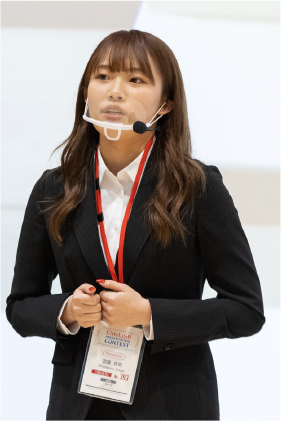
近森
環境問題に関心のない人々を巻き込むための2つ目の提案は 「マイ・オアシス・プロジェクト」です。このプロジェクトの目的は、繰り返し使える水筒である「マイボトル」を使うこと促しながら「ペットボトルゴミを減らす」ことです。
みなさんは外出するとき「マイボトル」を使っていますか?
「マイボトル」は気軽に実践できる具体的な行動のひとつです。「マイボトルを12回使用すれば、ペットボトルを買うよりも二酸化炭素の排出量が少なくなる」と言われています。しかし、NGOグリーンピースジャパンによると、マイボトルを持っている人のうち、実際に使っている人はわずか20%であるといいます。私もマイボトルを使わない時があります。なぜ、このようなことが起きてしまうのでしょうか?
私たちは上智大学の学生560人を対象に、マイボトルを持ち歩かない理由を調査をしました。共通して得られた回答は、環境には良いのはわかっているが…「給水機が少ない」そして「水筒が空になると結局ペットボトルを買ってしまう」というものでした。
これらの回答から私たちは、”どこに行っても簡単に水筒に飲み物を満たせる社会システム”があれば、これらの問題は解決し、人々のマイボトルを持ち歩く動機を高められるのではないかと考えました。
それを実現するのが「マイ•オアシス•プロジェクト」です。
この「マイ•オアシス•プロジェクト」では2つの仕組みを考えました。1つ目の仕組みとして、「マイ•オアシスボトル」という水筒をプロジェクトの一環として生産し、販売します。その売り上げの一部は公共の場所に設置するウォーターサーバーの購入と管理の資金に充てられます。
しかし、私たちはただウォーターサーバーの数を増やすだけではなく、人々にウォーターサーバーの情報を適切に提供するシステムも実現していきます。
このプロジェクトの2つ目の仕組みはQRコードです。このQRコードに携帯電話をかざすだけで、ウォーターサーバーの設置場所がわかるウェブサイトに飛びます。マイ•オアシスボトルにQRコードを印刷したり、ポスターとして公共の場に貼ったりすることで、近くにあるウォーターサーバーの情報を簡単に得られるのです。これにより、ペットボトルを買わないという選択肢が生まれます。
このプロジェクトを拡大していくために私たちはまず、プロジェクトに賛同してくれる大学や企業を探します。次に、プロジェクトに対する認知度と資金を高めるために、マイ•オアシスボトルを商品として流通させます。
実際に、私たちはこのプロジェクトを実行するために上智大学と協力しています。また、海外の主要都市ではウォーターサーバーが増えており、観光や自治体など、協賛の機会は多岐にわたると考えています。
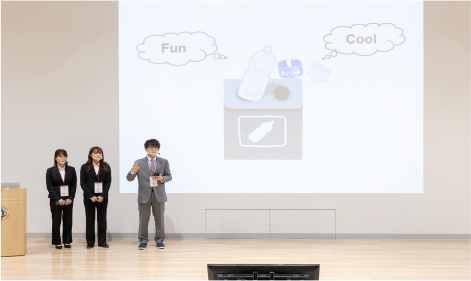
宮園
結論として、「究極の選択ボックス」と「マイ•オアシス•プロジェクト」はより多くの人々に強制することなく、エコアクションを起こすアイデアを提案します。私たちはこれら2つのアイデアで環境と人間がウィンウィンになる状況を創出できるよう工夫を加えていきます。そして、この2つのアイデアが持続可能な循環を構築していきます。
最後にマイケル・ジャクソンの言葉を引用します。「我々が世界であり、我々は子どもである」。私たちは、地球を守り、地球をより良い場所にするために真の結束が必要です。私たち自身、そして未来のために。ありがとうございました。